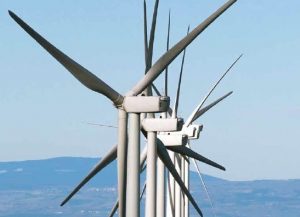A laser in Iowa State University’s Wind Energy Manufacturing Laboratory scanned layer after layer of the flexible fiberglass fabric used to make wind turbine blades. A computer took the laser readings and calculated how dozens of the layers would fit and flow over the curves of a mold used to manufacture a blade. And if there was a wrinkle or wave in the fabric, any defect at all, the technology was designed to find it. That’s because the last thing you want is a defect in a 40-meter wind turbine blade when it’s spinning in the wind.
“Waves in the fabric are bad because they can’t take the load,” says Vinay Dayal, an Iowa State associate professor of aerospace engineering. “And if a blade can’t take the load, bad things happen to the turbine,” according to John Jackman, associate professor of industrial and manufacturing systems engineering.
The two are working with Frank Peters and Matt Frank, associate professors of industrial and manufacturing systems engineering, to operate and develop Iowa State’s Wind Energy Manufacturing Lab. The lab has been open for about a year and was built as part of a three-year, $6.3 million research project. The study is a joint effort of researchers from TPI Composites, a Scottsdale, Arizona-based company that operates a turbine blade factory in Newton, and the U.S. Department of Energy’s Sandia National Laboratories in Albuquerque, New Mexico. The researchers’ goal is to develop new, low-cost manufacturing systems that could improve the productivity of turbine blade factories by as much as 35 percent.
The lab in Iowa State’s Sweeney Hall provides researchers the facilities and equipment they need to study how lasers can analyze the fiberglass fabric that’s used to manufacture turbine blades; develop technology for the nondestructive evaluation of turbine blades; analyze and improve wind blade edges; make precise 3-D laser measurements of 40-meter wind turbine blades; and develop new fabric manipulation techniques for automated blade construction.
Researchers say the lab has already advanced their understanding of turbine blade manufacturing and is helping to develop automation technologies that could one day be used in manufacturing plants. “In the early stages of the research there were a lot of investigations to understand all the problems we’re addressing,” Frank said. “But now we’re at that phase where real intellectual property is coming out of the lab.” Learn more at www.iastate.edu.



























